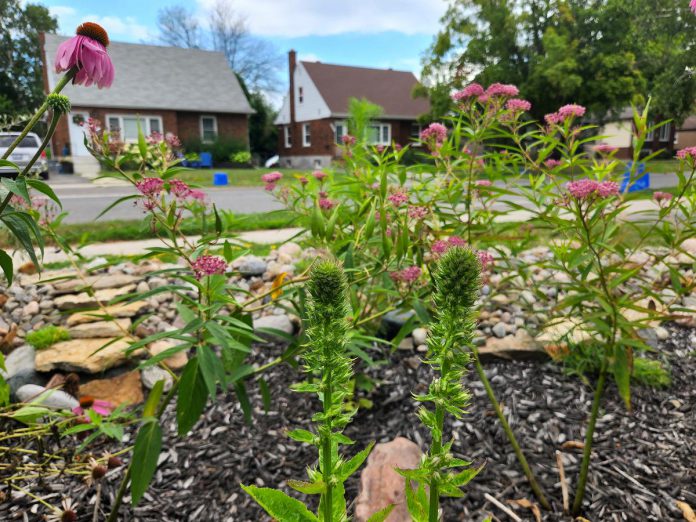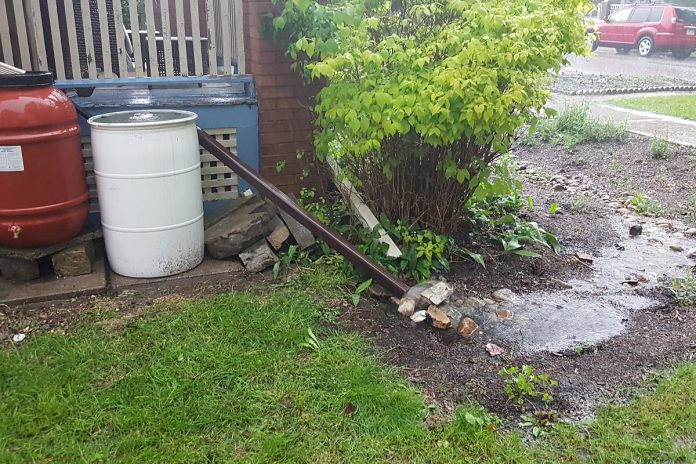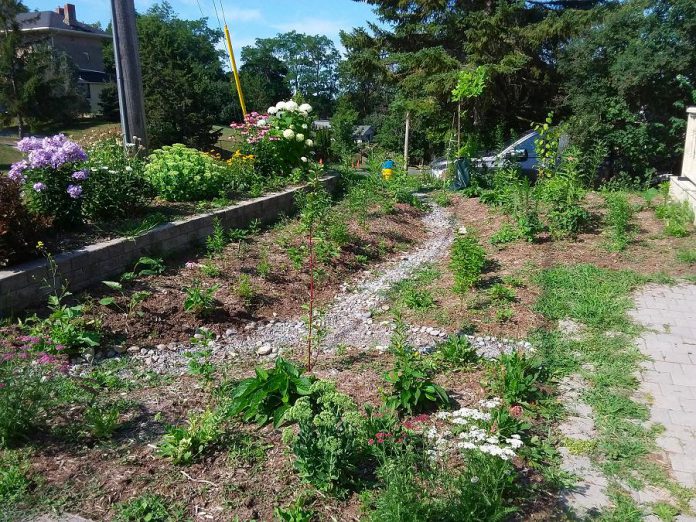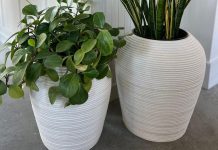
Another column about rain gardens? You betcha! After all, what’s not to love about a garden that supports the health of the local watershed and wildlife, reduces flooding, and enhances the curb appeal of your home, school, or business?
For those new to the concept, rain gardens are bowl-shaped gardens that take in stormwater runoff from nearby hard surfaces, such as a roof or an asphalt driveway. The plants and soil clean the rainwater by filtering out pollutants. Rain gardens come in many shapes, sizes, and styles, depending on the specifics of your space and your personal gardening style.
This week, we’re sharing five things you may not know about rain gardens.
1. Rain gardens don’t need a lot of water
Rain gardens are often dry. Unlike a pond, which holds water throughout the year, rain gardens are designed to temporarily store water until it can be absorbed into the ground.
Ideally, water in a rain garden will drain within 24 to 48 hours of a heavy rain event. During the summer, established rain gardens can go many weeks without water.
The best part? Fewer mosquitoes in your garden!
2. Rain gardens divert water from storm sewers

An average residential rain garden in Peterborough can divert about 1.5 cubic metres of water from the storm sewer system each year. That’s roughly the same volume as 9.5 bathtubs.
Keep in mind that bath water in Peterborough is treated before being returned to the Otonabee River, but roof runoff isn’t. Without treatment, runoff carries garbage and pollutants straight into the watershed.
By sending rainwater to a rain garden, you can harness the power of soil and plants to filter pollutants as water soaks into the ground. Imagine the potential for the watershed if more homeowners, schools, and businesses installed rain gardens on their properties. That’s a lot of bathtubs.
Rain gardens also help us adapt to the impacts of climate change, which include more precipitation in shorter amounts of time. They do this by reducing the amount of runoff the municipal stormwater system has to manage during heavy storms.
3. Rain gardens are fun!
Rain gardens provide wonderful entertainment.
As soon as you install one, you’ll fly out the door at the first hint of rain to watch the bowl fill and recede. Trust me!
4. You can include trees in your rain garden

You can incorporate trees into your rain garden if your space allows.
It’s important to build your rain garden outside the canopy of any existing trees to protect their roots. However, there’s no reason why you can’t plant a new tree in your rain garden. Planting trees is critical for adapting to climate change, especially since extreme weather events can damage the urban tree canopy.
Some of our favourites include River Birch (Betula nigra), Hackberry (Celtis occidentalis), Eastern White Cedar (Thuja occidentalis), and Serviceberry (Amelanchier spp.). These native trees and large shrubs are well-suited to the variable moisture conditions found in rain gardens and add height and year-round interest.
You can customize your rain garden with many native plants and trees so it becomes uniquely yours.
5. You can get financial help to install a rain garden
Eligible homeowners can receive up to $1,000 from the City of Peterborough to install a rain garden at home. That’s wild!
In addition to the subsidy, you get to enjoy all the secondary benefits that rain gardens offer, such as butterfly visits and the envy of your neighbours. Plus, GreenUP is partnering with the City of Peterborough to provide applicants with consultation visits and customized advice.

The application process begins with an eligibility assessment. Once you’re pre-approved, you will receive resources and support to design your own unique garden. Additionally, applicants can take advantage of up to two site visits by GreenUP staff during the design and installation process.
One of these visits is required and must take place during construction. The other visit can be used at a time of the applicant’s choosing, for additional advice on garden design, application support, maintenance or plant selection.
The subsidy covers the costs of plants, soil, mulch, rock, and other non-equipment expenses incurred while building a rain garden. The subsidy can also be used to hire a landscape contractor for design and/or construction, if desired.
It’s not too late to reap the benefits of a rain garden and receive a subsidy this year. For more information about the Rain Garden Subsidy program, visit www.peterborough.ca/raingarden, or direct questions to Hayley Goodchild at hayley.goodchild@greenup.on.ca or 705-748-3238 ext. 213.
GreenUP can help you source plants suitable for your rain garden. Visit the Ecology Park and speak to our staff in the Native Plant & Tree Nursery during our hours of operation, 10 a.m. to 6 p.m. on Thursdays and 10 a.m. to 6 p.m. on Fridays, Saturdays, and Sunday.


























